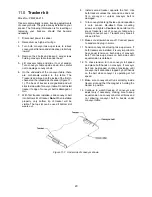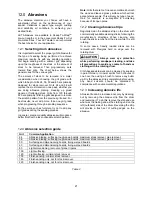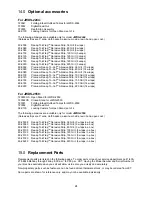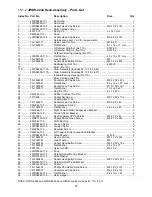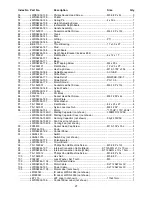
15
2. Open dust cover and remove abrasive strip
from drum.
3. Insert gauge (A, Figure 8-4) between drum and
conveyor table at outboard side.
Figure 8-4: drum alignment
4. With dust cover open, lower sanding drum while
slowly rotating drum by hand, until drum lightly
contacts gauge. NOTE: Make sure drum
contacts gauge, not just the tension rollers.
Make a note of the measurement on the
sander’s depth scale.
5. Remove gauge and place under drum at
inboard side.
6. If drum does not contact gauge equally on both
ends of drum, alignment is needed.
To align conveyor table with drum:
7. Loosen both table locks (B, Figure 8-4)
Loosen both table locks
before adjusting drum alignment. Failure to
comply may cause damage to table.
8. Turn knob (C) to raise or lower outboard end of
table. Follow directional marks on label: (+) to
raise, (-)
to
lower.
9. Tighten table locks (B).
8.6.1
Fine-tuning drum alignment
Note: This is an operational test for sanding boards
wider than the drum. Perform this procedure only
after you have become familiar with sander
operation.
When sanding boards wider than the drum, table
alignment is critical and table must be adjusted
exactly level to slightly lower on the outboard end.
This will prevent any ridges from developing in the
stock. Always check this on a piece of scrap wood,
as follows, before sanding the workpiece.
1. Run a piece of scrap wood approximately 6”
wide by 30” to 40” long through the sander
sideways so that end of board extends past
outboard side of drum.
2. Without changing drum height, rotate board
180° and sand the same side.
3. If a ridge is visible where the drum overlaps,
loosen both table locks (B, Figure 8-3) and
lower table at outboard end slightly by turning
knob (C).
4. Repeat this process until the ridge is eliminated
and entire board is sanded.
Note:
When sanding narrow stock (less than 16”),
return conveyor table to parallel position. Turn knob
opposite direction until lock nut (D, Figure 8-4) is
contacted. The lock nut provides a positive stop for
table parallelism.
8.7
Tension roller adjustment
The infeed and outfeed rollers are tensioned to
provide downward pressure on the workpiece to
prevent slippage on the feed conveyor. Tension
rollers have been set by the manufacturer, but
should be inspected and may require adjustment as
the sander receives use.
Improperly adjusted tension
rollers (i.e. those set too high, rendering them
non-functional) could allow kickback of pieces
being sanded.
You can increase or decrease tension roller
pressure by turning the screws on the tension roller
brackets (Figure 8-5).
Figure 8-5: tension adjustment screws
Too much tension roller pressure can result in a
“snipe” mark, which is a visible line located near the
end of the board and running across its width.
If snipe occurs on the leading end of board, adjust
outfeed tension roller. If the snipe occurs on trailing
end of board, adjust infeed tension roller.




















